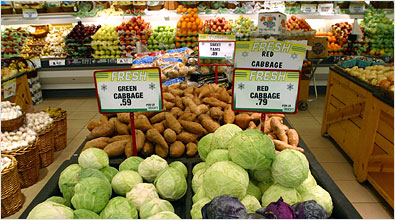By Tim York and Daniel Sumner
California’s drought is raising concerns about whether fresh produce grown in the Golden State could run short, potentially raising prices nationwide. The reality is that there was little jump in produce prices last year, and consumers should expect only slight increases in 2015. To appreciate why, one must understand a bit about the geography, water infrastructure and economics of California agriculture.
The drought hasn’t affected California’s diverse regions uniformly. Most crops come from two areas: the Central Valley, including the Sacramento and San Joaquin valleys; and the coastal region, including the Salinas Valley, which is often dubbed America’s “salad bowl.”
The Sacramento and San Joaquin valleys are home to significant production of alfalfa, silage, rice, cotton and other so-called field crops, but are also a major source of fresh produce, including peppers, melons, grapes, oranges, tree nuts and tomatoes. Farmers in these valleys have typically relied on a mix of pumped groundwater and surface water deliveries via both the Central Valley Project—a huge network of dams, reservoirs and canals—and the larger California State Water Project. Most farmers, however, will receive no water from the CVP for the second year in a row, and the SWP is delivering only a fraction of normal allocations.
This, coupled with much higher groundwater pumping costs as more and deeper wells are required, has forced many farmers to shift out of thirsty field crops. But this decreased production has minimal effects on food prices because California accounts for a small share of the supply, or because these crops affect food prices only indirectly. For example, fewer acres of corn silage makes it more expensive to feed milk cows, but the subsequent effect on the price of cheese is small. Fresh produce, which generates high revenue per unit of water consumed, continues to be planted.
In the coastal region and the Salinas Valley—where crops include strawberries, avocados, lettuce, celery, cauliflower, broccoli and wine grapes—farmers do not receive surface water from the CVP or the SWP. Instead, rainfall is stored in local reservoirs or underground aquifers. Lake San Antonio sits at 5% capacity, and Lake Nacimiento at 29%. But groundwater is still available and farmers find it economical, given the value of the produce they grow.
Roughly half of California’s water flows undiverted for human use. Another 40% goes to agriculture, and the remaining 10% to cities. The environment requires a certain baseline of water that cannot be reallocated in a drought. Urban use is small and hard to change much, though Democratic Gov. Jerry Brown’s recently announced 25% mandatory reduction may help some. The bulk of water cutbacks will fall on agriculture but plumbing and economics determine where they will be made.
California voters passed a $7.5 billion water bond measure last fall, with $2.7 billion going toward increased storage. Legislation allowing regulation of groundwater will be implemented gradually over the next several years. These solutions will help, eventually.
Some farmers are adjusting planting schedules and shifting crops between growing regions to adapt. Others are rerouting water from annual field crops, which can be left unplanted for a year or two, to permanent crops such as fruit and nut trees. These adjustments assure a reliable supply to consumers, but they raise prices. Even so, this is a small factor compared with other costs. Produce prices are more likely to be influenced by labor shortages and the increase in California’s minimum wage in January 2016 to $10 an hour from the current $9. Governments in the region could scare off produce farmers if they were to place tight restrictions on irrigation practices. But that seems unlikely, at least for now.
So what does this mean for consumers? Even if water remains short over the next decade, an adequate supply of fresh fruits and vegetables should not be a concern. In a global market, produce suppliers from the U.S., Mexico, Chile and beyond compete to keep prices low. The rising cost of water in California is likely to increase the cost of production over time, and that will be reflected in gradually higher retail prices. But Golden State farms will remain reliable suppliers of the produce that consumers have come to expect.
Mr. York is the CEO of Markon Cooperative, a fresh-produce food-service purchasing cooperative. Mr. Sumner is the director of the University of California Agricultural Issues Center.



